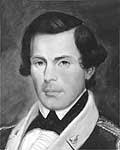
Born in 1744, as the son of a well known Quaker blacksmith and the nephew of Attwood Shute, the Mayor of Philadelphia, Samuel Nicholas had many advantages early in life. At age 7, his uncle paid for him to attend the Philadelphia Academy. When what is now known as the University of Pennsylvania was established in 1754, it quickly became affiliated with the prestigious Philadelphia Academy. Nicholas finished his studies at the Academy in 1759 at the age of 15. Nicholas became heavily involved with high society upon graduation.
When he turned 16, he was admitted into the Schuylkill Fishing Company, a very exclusive club in Philadelphia. Not long after, in 1766, he organized the Gloucester Fox Hunting Club, one of the first hunting clubs in America. He was also involved in the Patriotic Association of Philadelphia. Two years after organizing the Gloucester Fox Hunting Club, Nicholas married Mary Jenkins, daughter of a well established businessman. Her family owned the Connestogoe Wagon, a business Nicholas took over after his marriage. The spelling of the establishment was later changed to the now familiar Conestoga, but Connestogoe is documented in The Philadelphia Directory for 1785. Nicholas and his wife had three children, a daughter who was said to be engaged to Washington Irving, and two sons, Samuel, Jr., and Charles Jenkins Nicholas. Not because of any formal military training, but because of his established role in Philadelphia society, when the Second Continental Congress began looking for men to fight in the Navy, they contacted Samuel Nicholas to assist them.
Nicholas was officially commissioned as Captain of the Marines on November 5, 1775. At that time, the Marines were officially started as a branch of the Navy ready to fight for independence on shore and at sea. The Marines were considered more quickly trained as combat fighters rather than strategic fighters. Five days later, on November 10, the Second Continental Congress allowed two battalions of Marines to be enlisted. Later that month, on November 28, Nicholas’ commission was confirmed by Congress and signed by John Hancock. His pay was initially set at $32 per month. When asked to design the uniforms for the Marines, Nicholas used as a template the outfits of the Gloucester Fox Hunting Club whose hunting uniforms used a leather collar. Nicholas carried these collars over to the uniforms of the Marines, which is how Marines came to be known as “leathernecks.”
His initial assignment was to gather the men who would be the first Marines. Because of his business, the Connestogoe Wagon Tavern, it was assumed that he would know the type of tough men willing to fight. He was successful in that endeavor and ended up gathering five companies of Marines.
In March, 1776, Nicholas commanded the Marine detachment aboard the Alfred with Commodore Hopkins in charge. His first mission to Nassau in the Bahamas was a success. The Americans captured two forts, 88 cannons, 15 mortars, and other military weaponry from the British. That raid was regarded as the most successful American Naval operation of the Revolutionary War. He was promoted to major on June 25, 1776.
Soon after, Nicholas reported back to Philadelphia to resume recruiting. He took the men he had enlisted with him to assist in the Trenton-Princeton Campaign, the historic battle in the Revolutionary War beginning on Christmas Day. In it, Nicholas assisted General Washington in defeating the Hessians in Trenton and Princeton, New Jersey. After those victories, Nicholas again returned to Philadelphia in June 1778 after the evacuation of the British from the city to continue recruiting and training efforts.
Five years later, the 39-year-old Nicholas gave up his military life and resumed civilian life. He was a member of the Pennsylvania Society of Cincinnatorium from 1785 until 1788, serving on the standing committee. More commonly known as The State Society of the Cincinnati of Pennsylvania, it was established honor those people who “gave up everything to serve the Republic” during the Revolutionary War. The Society is named for Roman General Lucius Quintus Cincinnatus, who quit his farm to fight for his country, and when finished with military duties, declined any awards he was to receive and returned to his farm. George Washington and Alexander Hamilton are among the prominent Presidents of the Society. Two years after giving up the Society, Nicholas died on August 27, 1790, during a yellow fever epidemic. Because of his Quaker background, he was buried in the Society of Friends Cemetery, though earlier cast out of the Quaker Church because of his involvement in the military. In his memory, the naval destroyer Nicholas was named for him on May 12, 1919.
Nicholas’ life and contributions to the Marine Corps have not been forgotten. Every November 10, the celebrated birthday of the Marine Corps (the day the first battalions were enlisted in 1775), Marines gather at the Quaker meetinghouse cemetery at Fourth and Arch Streets in Philadelphia. Because the exact location of his grave is unknown, Marines from the University of Pennsylvania ROTC program gather at an unmarked marble tomb in the cemetery. The Quakers are against war, the reason Nicholas was “read out of meeting,” or excommunicated. When the Marines asked if they could hold a ceremony in his honor at the meeting house, the Religious Society of Friends was initially against it, but eventually allowed it on the terms that they keep it low-key.
The Marines, therefore, come, lay a wreath, and salute silently before dismissing themselves every year.
No comments:
Post a Comment